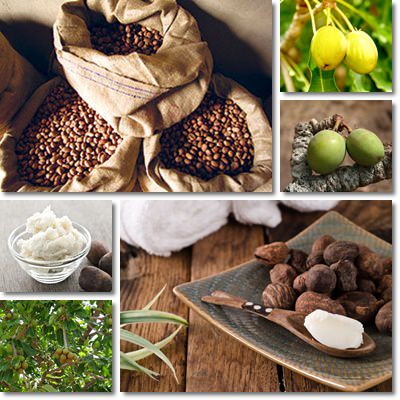The shea nut is the fruit of the Shea tree (Vitellaria paradoxa), indigenous to the African continent. Shea nuts are the source of the popular shea butter, the main active ingredient in a variety of hair and skin care products. Both shea butter and oil, the two main byproducts of the shea nut, are edible. However, outside local African communities shea butter is primarily appreciated for its healing dermatological properties.
Pure shea butter and shea butter-based products are renowned for their antioxidant, anti-inflammatory, moisturizing and skin healing activity and are novelty ingredients in a variety of skin and hair care products. The repairing action of the butter is a result of its natural content of fatty acids, both saturated and unsaturated, as well as vitamin A and vitamin E content, two nutrients of extreme importance for skin, nail and hair health.

What does the shea nut look like?
The fruit of the Shea tree, also known as the karité tree, is a smooth, slightly oval nut, containing a single fatty kernel. When unripe, shea (karité) nuts have a green husk; as they ripen, the husk dries up, leaving behind a hard, brown shell which needs to be cracked in order to reach the fatty kernel.
Why is it called shea butter?
In order to make regular butter, buttermilk is beaten in cold and hot water until the fat rises to the surface. For shea butter, shea (karité) nuts are cracked, then grilled in order to extract the buttery kernel which is then boiled until the fat rises to the surface of the water, similar to regular butter, hence the name ‘shea (karité) butter’. As a result of using this extracting method, high-quality unrefined shea butter is obtained.
What does shea butter look and taste like?
Shea butter ranges in color slightly from creamy white to pale yellow and is both odorless and tasteless. Both shea (karité) butter and oil can be used for cooking, hair and skin care. The fresher, the better. The longer the product is stored, the more it starts losing its healing properties.

Shea nut butter benefits and uses
What are the cosmetic properties and health benefits of shea nut butter?
Karité (shea) butter is a rich source of essential fatty acids, antioxidants and vitamins E and A. Overall, it is used to improve or treat various skin conditions ranging from plain rashes and eczema to burns, scars and blemishes. It revitalizes and strengthens brittle hair, moisturizes skin and prevents wrinkles, cracked skin or chopped lips. Also, shea butter offers moderate UV protection for both skin and hair. See below my list of the 7 most prominent properties of shea nut butter.
Softens and regenerates skin
Shea butter is about 90% fat, containing both saturated fatty acids (arachidic, palmitic and stearic acid) and unsaturated fatty acids in the form of Omega-6 (linoleic acid) and Omega-9 (oleic acid) fatty acids. This makes it an excellent skin moisturizer. Moreover, it is absorbed quickly because it melts when in contact with the heat of the skin. Using unrefined shea butter is preferable because the extraction method ensures the butter preserves all of its properties.
Anti-wrinkle action
Consistent use of shea nut butter for skin care can help prevent premature wrinkles and improve skin appearance. This is done in two ways. First of all, vitamins A and E and phenolic substances known as catechins confer shea (karité) butter its potent antioxidant properties. Being applied at the level of the skin, it provides on the spot protection against free radicals which cause, among other things, aging of the skin in the form of wrinkles and saggy skin.
Secondly, shea butter is rich in unsaturated fatty acids (Omega-6 and Omega-9) which not only boast antioxidant activity, but also moisturize the skin. According to beauty experts, a well-hydrated, moisturized skin is less prone to developing wrinkles and other visible aging signs.
Offers UV protection
In shea butter, vitamin A and vitamin E, unsaturated fatty acids and cinnamic acid exhibit powerful antioxidant activity. In relation to sun exposure, karité butter protects, to a fairly limited extent, against UV radiation from the sun, preventing skin damage, sun burns, scars from peeling skin and premature aging. Applied after sun exposure, it helps nourish and repair the skin. However, its solar protection factor is minimal so it’s not recommended to substitute commercial SPF lotions with shea butter. Instead, it can be used as a natural alternative to after-sun lotions and reparative skincare products.
Universal skin care product
Raw shea butter can be applied locally to treat rashes, eczema, sun burns, scaly, dry skin and improve overall skin appearance. Some women claim that raw shea butter is efficient against stretch marks as well, provided it is applied from the incipient stages. These skin healing properties are due to the excellent emollient and antioxidant properties of the butter, which allow the skin to regenerate properly. Lip care product: Being a wonderful natural emollient, shea butter is efficient against chapped lips and, at the same time, offers a limited form of UV protection.
Nourishes and repairs dry, brittle hair
Shea butter is good for dry scalp and brittle, dull hair. Being rich in healthy fatty acids, shea (karité) butter moisturizes the scalp and strengthens brittle hair, giving it a healthy shine. If possible, look for unrefined shea butter and apply it weekly on damaged hair.
Anti-inflammatory and anti-tumor activity
Shea butter contains lupeol cinnamate, a substance which has exhibited anti-tumor proliferation and anti-inflammatory properties in laboratory models.
Anti-allergic potential
Shea butter might help reduce the severity of allergic reactions. The anti-inflammatory properties of lupeol cinnamate appear to inhibit overproduction of IL-4 (interleukin-4), a protein responsible for triggering severe immune system responses in the presence of common allergens. However, there is extremely poor research on the subject. Most important, if you are allergic to shea nuts and shea butter, avoid the product in all forms and preparations to prevent potentially serious allergic reactions.
Conclusion
Overall, shea butter is an excellent moisturizer, with impressive antioxidant and anti-inflammatory properties. When choosing hair and skin care products it is best to look for brands which provide the highest percentage of shea (karité) butter. But remember: skin and hair shea butter-based products are not edible, so don’t go nibbling on your lip balm.
